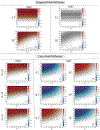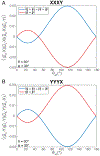A Proposed Method to Obtain Surface Specificity with Pump-Probe and 2D Spectroscopies
- PMID: 32255629
- PMCID: PMC7993518
- DOI: 10.1021/acs.jpca.9b11791
A Proposed Method to Obtain Surface Specificity with Pump-Probe and 2D Spectroscopies
Abstract
Surfaces and interfaces are ubiquitous in nature. From cell membranes, to photovoltaic thin films, surfaces have important function in both biological and materials systems. Spectroscopic techniques have been developed to probe systems like these, such as sum frequency generation (SFG) spectroscopies. The advantage of SFG spectroscopy, a second-order spectroscopy, is that it can distinguish between signals produced from molecules in the bulk versus on the surface. We propose a polarization scheme for third-order spectroscopy experiments, such as pump-probe and 2D spectroscopy, to select for surface signals and not bulk signals. This proposed polarization condition uses one pulse perpendicular compared to the other three to isolate cross-peaks arising from molecules with polar and uniaxial (i.e., biaxial) order at a surface, while removing the signal from bulk isotropic molecules. In this work, we focus on two of these cases: XXXY and YYYX, which differ by the sign of the cross-peak they create. We compare this technique to SFG spectroscopy and vibrational circular dichroism to provide insight to the behavior of the cross-peak signal. We propose that these singularly cross-polarized schemes provide odd-ordered spectroscopies the surface-specificity typically associated with even-ordered techniques.
Figures






References
-
- Özdirekcan S; Rijkers DTS; Liskamp RMJ; Killian JA Influence of Flanking Residues on Tilt and Rotation Angles of Transmembrane Peptides in Lipid Bilayers. A Solid-State 2H NMR Study. Biochemistry 2005, 44, 1004–1012. - PubMed
-
- Ho J; Psciuk BT; Chase HM; Rudshteyn B; Upshur MA; Fu L; Thomson RJ; Wang HF; Geiger FM; Batista VS Sum Frequency Generation Spectroscopy and Molecular Dynamics Simulations Reveal a Rotationally Fluid Adsorption State of α-Pinene on Silica. J. Phys. Chem. C 2016, 120, 12578–12589.
-
- Nihonyanagi S; Yamaguchi S; Tahara T Ultrafast Dynamics at Water Interfaces Studied by Vibrational Sum Frequency Generation Spectroscopy. Chem. Rev 2017, 117, 10665–10693. - PubMed
-
- Zhang Z; Piatkowski L; Bakker HJ; Bonn M Ultrafast Vibrational Energy Transfer at the Water/Air Interface Revealed by Two-Dimensional Surface Vibrational Spectroscopy. Nat. Chem 2011, 3, 888–893. - PubMed
Grants and funding
LinkOut - more resources
Full Text Sources

